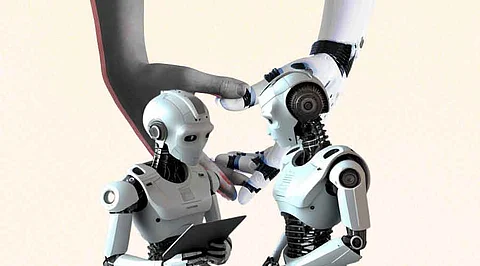
- Insights
- Cryptocurrencies
- Stocks
- White Papers
- Industry
- Geography
- Insights
- Cryptocurrencies
- Stocks
- White Papers
- Industry
- Geography


In an era defined by rapid technological advancements, the boundaries between humans and machines are becoming increasingly blurred, giving rise to the age of humanoid robot companions. These remarkable creations represent a remarkable fusion of cutting-edge technology and social interaction, ushering in a future that was once confined to the realms of science fiction. The concept of robots as mere tools is evolving as these humanoid companions offer not only functionality but also emotional engagement.
This article embarks on a journey into the world of humanoid robot companions, exploring their immense potential, current applications, and the profound impact they promise to have on our daily lives. As these robots take their place in our society, we find ourselves on the cusp of a revolution in human-machine interaction, one that has the power to reshape our world.
The concept of robots designed to interact with humans on a social and emotional level has intrigued scientists and engineers for decades. Today, we are witnessing the fruits of their labor as humanoid robot companions become a reality. These robots, often designed to resemble humans in form and behavior, are engineered to not only perform tasks but to engage in social and emotional interactions.
Companionship: Loneliness and social isolation are growing concerns in modern society. Humanoid robot companions have the potential to provide companionship to those who may be isolated, including the elderly and individuals with disabilities.
Mental Health Support: These robots can be programmed to provide emotional support and encourage positive mental health practices. They have the ability to detect signs of distress and offer comfort.
Education and Skill Development: Humanoid robot companions can serve as educational aids for children, helping them learn and develop essential skills. Their interactive nature makes learning engaging and fun.
The adoption of humanoid robot companions is already underway in various sectors:
Elderly Care: In countries with aging populations, humanoid robots are being used to provide companionship and assist with daily tasks for the elderly.
Education: Robots are increasingly used in educational settings, helping children with learning and social development. They can be personalized to adapt to individual needs.
While the potential of humanoid robot companions is exciting, several challenges must be addressed:
Ethical Concerns: The integration of robots into daily life raises ethical questions, such as robot rights, privacy concerns, and the potential for misuse.
Cost and Accessibility: Developing and deploying humanoid robot companions can be expensive. Ensuring accessibility to all individuals, regardless of their financial means, is a critical challenge.
As technology advances, we can expect to see more widespread use of humanoid robot companions. Here are some potential developments on the horizon:
Emotional Intelligence: Future robots will likely have advanced emotional intelligence, allowing them to understand and respond to human emotions more accurately.
Enhanced Mobility: Improved mobility will enable robots to navigate complex environments more effectively, making them more versatile.
AI Advancements: The integration of advanced artificial intelligence will make these robots more adaptable and capable of learning from their interactions.
Customization: The ability to personalize humanoid robot companions to suit individual needs and preferences will become more prevalent.
The rise of humanoid robot companions has the potential to reshape society in various ways:
Reducing Loneliness: With companionship provided by robots, we can mitigate the effects of loneliness and social isolation, particularly among the elderly.
Healthcare Advancements: Humanoid robot companions can assist medical professionals and patients, potentially improving healthcare outcomes.
Personalized Education: The use of robots in education can lead to more personalized and effective learning experiences for students.
With great technological advancements come ethical responsibilities. The development and deployment of humanoid robot companions raise crucial ethical questions:
Privacy: As these robots become an integral part of our lives, the collection and use of personal data must be carefully regulated to protect privacy.
Transparency: Developers must be transparent about how these robots operate and the data they collect.
Robot Rights: As robots become more sophisticated, questions about their rights and ethical treatment come to the forefront.
